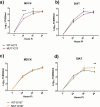Characterization of Influenza B Virus Variants with Reduced Neuraminidase Inhibitor Susceptibility
- PMID: 30201817
- PMCID: PMC6201084
- DOI: 10.1128/AAC.01081-18
Characterization of Influenza B Virus Variants with Reduced Neuraminidase Inhibitor Susceptibility
Abstract
Treatment options for influenza B virus infections are limited to neuraminidase inhibitors (NAIs), which block the neuraminidase (NA) glycoprotein on the virion surface. The development of NAI resistance would therefore result in a loss of antiviral treatment options for influenza B virus infections. This study characterized two contemporary influenza B viruses with known resistance-conferring NA amino acid substitutions, D197N and H273Y, detected during routine surveillance. The D197N and H273Y variants were characterized in vitro by assessing NA enzyme activity and affinity, as well as replication in cell culture compared to those of NAI-sensitive wild-type viruses. In vivo studies were also performed in ferrets to assess the replication and transmissibility of each variant. Mathematical models were used to analyze within-host and between-host fitness of variants relative to wild-type viruses. The data revealed that the H273Y variant had NA enzyme function similar to that of its wild type but had slightly reduced replication and transmission efficiency in vivo The D197N variant had impaired NA enzyme function, but there was no evidence of reduction in replication or transmission efficiency in ferrets. Our data suggest that the influenza B virus variant with the H273Y NA substitution had a more notable reduction in fitness compared to wild-type viruses than the influenza B variant with the D197N NA substitution. Although a D197N variant is yet to become widespread, it is the most commonly detected NAI-resistant influenza B virus in surveillance studies. Our results highlight the need to carefully monitor circulating viruses for the spread of influenza B viruses with the D197N NA substitution.
Keywords: influenza B; neuraminidase inhibitor; resistance; viral fitness.
Copyright © 2018 Farrukee et al.
Figures




Similar articles
-
Influenza B viruses from different genetic backgrounds are variably impaired by neuraminidase inhibitor resistance-associated substitutions.Antiviral Res. 2020 Jan;173:104669. doi: 10.1016/j.antiviral.2019.104669. Epub 2019 Nov 29. Antiviral Res. 2020. PMID: 31790712 Free PMC article.
-
In Vitro and In Vivo Characterization of Novel Neuraminidase Substitutions in Influenza A(H1N1)pdm09 Virus Identified Using Laninamivir-Mediated In Vitro Selection.J Virol. 2019 Mar 5;93(6):e01825-18. doi: 10.1128/JVI.01825-18. Print 2019 Mar 15. J Virol. 2019. PMID: 30602610 Free PMC article.
-
Competitive fitness of influenza B viruses with neuraminidase inhibitor-resistant substitutions in a coinfection model of the human airway epithelium.J Virol. 2015 Apr;89(8):4575-87. doi: 10.1128/JVI.02473-14. Epub 2015 Feb 11. J Virol. 2015. PMID: 25673705 Free PMC article.
-
Influenza neuraminidase inhibitors: antiviral action and mechanisms of resistance.Influenza Other Respir Viruses. 2013 Jan;7 Suppl 1(Suppl 1):25-36. doi: 10.1111/irv.12047. Influenza Other Respir Viruses. 2013. PMID: 23279894 Free PMC article. Review.
-
Neuraminidase inhibitor resistance in influenza: a clinical perspective.Curr Opin Infect Dis. 2018 Dec;31(6):520-526. doi: 10.1097/QCO.0000000000000498. Curr Opin Infect Dis. 2018. PMID: 30299356 Review.
Cited by
-
Predicting Permissive Mutations That Improve the Fitness of A(H1N1)pdm09 Viruses Bearing the H275Y Neuraminidase Substitution.J Virol. 2022 Aug 10;96(15):e0091822. doi: 10.1128/jvi.00918-22. Epub 2022 Jul 14. J Virol. 2022. PMID: 35867563 Free PMC article.
-
Genetic characterization and whole-genome sequencing-based genetic analysis of influenza virus in Jining City during 2021-2022.Front Microbiol. 2023 Jun 22;14:1196451. doi: 10.3389/fmicb.2023.1196451. eCollection 2023. Front Microbiol. 2023. PMID: 37426015 Free PMC article.
-
Influenza B viruses from different genetic backgrounds are variably impaired by neuraminidase inhibitor resistance-associated substitutions.Antiviral Res. 2020 Jan;173:104669. doi: 10.1016/j.antiviral.2019.104669. Epub 2019 Nov 29. Antiviral Res. 2020. PMID: 31790712 Free PMC article.
-
In vitro and in vivo characterization of SARS-CoV-2 strains resistant to nirmatrelvir.Nat Commun. 2023 Jul 4;14(1):3952. doi: 10.1038/s41467-023-39704-x. Nat Commun. 2023. PMID: 37402789 Free PMC article.
-
Isolation of human antibodies against influenza B neuraminidase and mechanisms of protection at the airway interface.Immunity. 2024 Jun 11;57(6):1413-1427.e9. doi: 10.1016/j.immuni.2024.05.002. Epub 2024 May 31. Immunity. 2024. PMID: 38823390 Free PMC article.
References
-
- Gutiérrez-Pizarraya A, Perez-Romero P, Alvarez R, Aydillo TA, Osorio-Gomez G, Milara-Ibanez C, Sanchez M, Pachon J, Cordero E. 2012. Unexpected severity of cases of influenza B infection in patients that required hospitalization during the first postpandemic wave. J Infect 65:423–430. doi: 10.1016/j.jinf.2012.07.004. - DOI - PubMed
-
- von Itzstein, Wu WY, Kok GB, Pegg MS, Dyason JC, Jin B, Van Phan T, Smythe ML, White HF, Oliver SW, Colman PM, Varghese JN, Ryan MD, Woods JM, Bethell RC, Hotham VJ, Cameron JM, Penn CR. 1993. Rational design of potent sialidase-based inhibitors of influenza virus replication. Nature 363:418–423. doi: 10.1038/363418a0. - DOI - PubMed
Publication types
MeSH terms
Substances
Grants and funding
LinkOut - more resources
Full Text Sources
Other Literature Sources
Molecular Biology Databases

